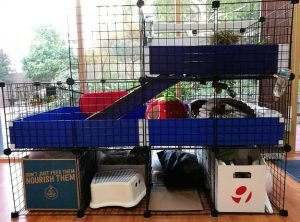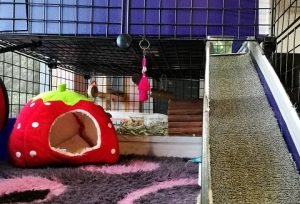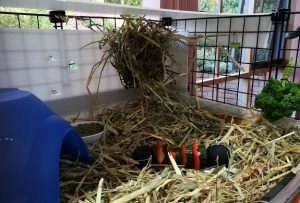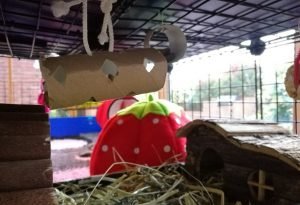Once you have decided on whether you will house your guinea pigs indoors or outdoors, the next exciting thing is planning out your setup. We wanted our guinea pigs cage to be comfortable and roomy enough to allow us to introduce a range of toys and hidey holes for our cute guinea pigs. We also wanted the cage to be practical for us as well.
 We built a three-level C&C cage. The base level is designed for storage (food, treats, bedding, guinea pig care and grooming products. The second level is the guinea pigs main roaming area, which includes their play area, tunnel, hidey holes and their sleeping quarters, which also features a water bottle and food bowl. The third level is the loft area and has been set up as the guinea pigs kitchen area, their main feeding place. This level features a water bottle, hay rack, veggie lifter, food bowl and hidey hole.
We built a three-level C&C cage. The base level is designed for storage (food, treats, bedding, guinea pig care and grooming products. The second level is the guinea pigs main roaming area, which includes their play area, tunnel, hidey holes and their sleeping quarters, which also features a water bottle and food bowl. The third level is the loft area and has been set up as the guinea pigs kitchen area, their main feeding place. This level features a water bottle, hay rack, veggie lifter, food bowl and hidey hole.
The base level has been designed to be open at the one hand for easy access to all your guinea pigs needs. Creating storage space at the bottom means that the main areas you will need to access for feeding and spot cleaning are at a higher level and hence easier to access and less strenuous on your back. The main level has a special design feature of double doors at the end of the guinea pigs sleeping quarters for practicality, allowing for easy access to everything from cleaning to changing food bowls and providing treats. The loft level also features a partial roof to provide the guinea pigs with more privacy, as they generally prefer to hide in darker areas. This partial roof is also great for supporting a blanket that we drape over in cooler weather to ensure the guinea pigs are kept warm and comfy. The guinea pigs access the different levels via the ramp, which is great for encouraging movement and makes the enclosure more interesting for them. Every guinea pig is different and some may not accustom to ramps. Both of our guinea pigs are rescue animals and adults (given births and 1 year of age) by the time we adopted them and had not been exposed to a ramp before. However, they learnt to use it quickly (training and encouraging them with food helped) and they love it now. Browny uses it a lot, often darting up and down the ramp for fun.
 C&C (cubes and corflute/corplast) cages are made from wire grids generally 35x35cm with gaps small enough to ensure that your guinea pigs are safe inside. Depending on the size of your cage design, work out how many grids you need before heading to the store. These C&C can easily be sourced online or hardware stores and come with connectors. Once the cage if assembled, you must ensure all the grids are secured in place with cable ties pulled tight. Cut off all excess cable tie lengths, and ensure there are no sharp edges that your guinea pigs can come in contact and hurt themselves with. The corflute/corplast which create the boxed base that sit on top of the grids can also be sourced from specialty online stores or hardware stores like Bunnings or Walmart. The ramp does require supporting metal rods inside the corflute, so you may like to buy ready-made ones from guinea pig specialty stores. Also, a supporting rod for the loft level would be ideal, though not entirely essential as the weight placed on it is minimal. This supporting rod is best sourced through specialty guinea pig stores.
C&C (cubes and corflute/corplast) cages are made from wire grids generally 35x35cm with gaps small enough to ensure that your guinea pigs are safe inside. Depending on the size of your cage design, work out how many grids you need before heading to the store. These C&C can easily be sourced online or hardware stores and come with connectors. Once the cage if assembled, you must ensure all the grids are secured in place with cable ties pulled tight. Cut off all excess cable tie lengths, and ensure there are no sharp edges that your guinea pigs can come in contact and hurt themselves with. The corflute/corplast which create the boxed base that sit on top of the grids can also be sourced from specialty online stores or hardware stores like Bunnings or Walmart. The ramp does require supporting metal rods inside the corflute, so you may like to buy ready-made ones from guinea pig specialty stores. Also, a supporting rod for the loft level would be ideal, though not entirely essential as the weight placed on it is minimal. This supporting rod is best sourced through specialty guinea pig stores.
 Furnishing your guinea pigs C&C cage is up to personal taste. We use a Vetbed for a luxurious soft covering for their delicate little feet. For the kitchen and sleeping quarters, we use more traditional bedding materials, such as hemp and hay (after trialing a number of different options). The guinea pigs cage must provide the basics of hidey holes, clean food bowls, clean water bottles and safe toys to alleviate boredom. Our guinea pigs have the comfort of lounging logs and wood huts or cosy fleece hideouts depending on their temperature needs.
Furnishing your guinea pigs C&C cage is up to personal taste. We use a Vetbed for a luxurious soft covering for their delicate little feet. For the kitchen and sleeping quarters, we use more traditional bedding materials, such as hemp and hay (after trialing a number of different options). The guinea pigs cage must provide the basics of hidey holes, clean food bowls, clean water bottles and safe toys to alleviate boredom. Our guinea pigs have the comfort of lounging logs and wood huts or cosy fleece hideouts depending on their temperature needs.
 Besides needing companionship, guinea pigs also need to be kept active and entertained, so simple boredom busters like hiding treats in cardboard boxes or in toilet paper rolls hanging off the loft roof do wonders. Browny has mastered the art of knocking out the goodies with her nose. Another simple guinea pig boredom breaker is to regularly re-arrange their enclosure and change over toys, so their cage is kept interesting and encourages them to explore. You can also change location of where their favourite bunch of leafy greens might appear by tying them to different areas of the cage with a rubber band looped through the grids – just be sure to discard of any uneaten food for hygiene purposes.
Besides needing companionship, guinea pigs also need to be kept active and entertained, so simple boredom busters like hiding treats in cardboard boxes or in toilet paper rolls hanging off the loft roof do wonders. Browny has mastered the art of knocking out the goodies with her nose. Another simple guinea pig boredom breaker is to regularly re-arrange their enclosure and change over toys, so their cage is kept interesting and encourages them to explore. You can also change location of where their favourite bunch of leafy greens might appear by tying them to different areas of the cage with a rubber band looped through the grids – just be sure to discard of any uneaten food for hygiene purposes.
The process of designing and setting up your guinea pig cage is both exciting and fun. If you have children get them involved and use the opportunity to teach maths (great motivation for learning about areas, perimeters and working out how many grids and connectors you will need) and 3D drawing (sketching the ideal guinea pig cage design, proportions and ratios). You would have never thought that choosing to have awesome cute guinea pigs as pets could be so educational and rewarding. Whatever you chose to do, remember to have fun and enjoy the process – it’s well worthwhile and your guinea pigs will love you for it!
